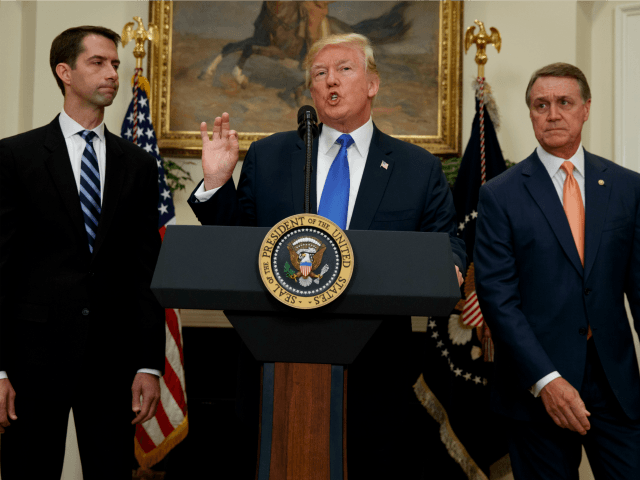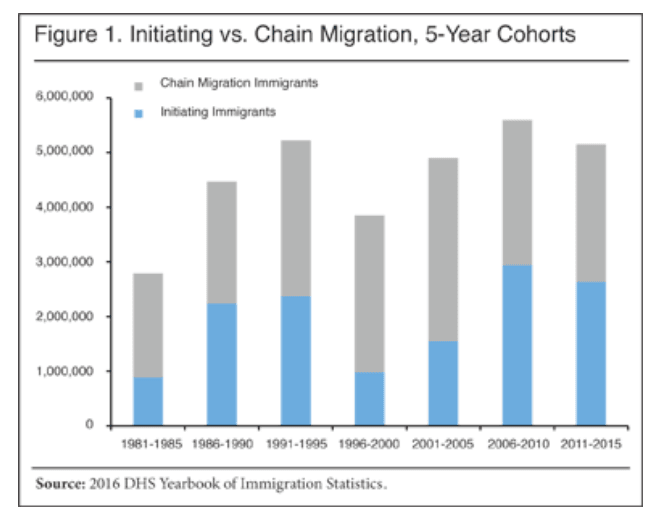President Donald Trump and a group of GOP Senators are urging the GOP’s House leadership to exclude any DACA amnesty from the year-end budget debate.
The message came from several Senators after a Thursday meeting with the President at the White House.
“The president made it very clear that he doesn’t want to see any DACA legislation as part of a year-end package,” said Georgia Sen. David Perdue, the author of the Trump-backed RAISE bill, which would raise Americans’ wages by ending the chain-migration inflow of new workers.
“Absolutely not on the [budget] omnibus under no circumstances,” said Arkansas Sen. Tom Cotton. GOP leader “Sen. [Mitch] McConnell says the same thing,” he added.
“This is not going to be part of the year-end omnibus or CR,” said Texas Sen. John Cornyn. The “CR” is Congress-speak for an end-of-year budget package.
The no-budget-amnesty message was delivered as GOP leaders debate whether to accept defeat by passing a DACA-amnesty in December or to block a DACA amnesty before the 2018 election, or instead go for an immigration win. That win might be achieved by trading an amnesty for a larger reduction of migrants arriving via annual chain-migration into the United States.
The no-budget-amnesty request to GOP leaders suggests that Trump and his deputies are huddling with GOP Senators to develop an ambitious plan, based on rollback of chain-migration.
Democrats scoffed at the request and suggested that Democrats have the power to package an amnesty with the 2018 budget vote in December. Politico reported:
“Republicans can talk to themselves in the mirror all they want,” said Drew Hammill, a spokesman for House Minority Leader Nancy Pelosi (D-Calif.). “But the fact is the vote is the currency of the realm and Republicans frequently find themselves holding an empty wallet.”
The GOP’s new emphasis on chain-migration is driven by a desire to minimize the impact of any DACA amnesty. An amnesty could put up to 3 million illegals on track to citizenship — and so give them all the legal right to bring in another huge wave of chain-migrants.
After the 1986 amnesty, a huge wave of Mexican chain-migration turned the state blue and created the huge civic and economic divides that helped the Democratic Party to become dominant in the state.
The focus on chain-migration comes as legislators and the public recognize the risks of the annual visa-lottery program, which provided a green card to the Islamic immigrant who apparently murdered eight cyclists in New York.
The visa lottery awards green cards to roughly 50,000 unscreened people — and eventually, to their chain-migration family relatives. The process leaves immigration officials with no ability to weigh the education, the economic merits and the security risks of the lottery-winners — or their chain-migration relatives.
Chain-migration annually delivers roughly 400,000 additional unscreened people to the United States each year. The huge inflow is central to the Democrats’ policy strategy of political victory via imported lower-skill, government-dependent voters.
However, many U.S.-first voters may be hostile to a policy shift from the long-standing defense against amnesty towards a risky chain-migration-for-amnesty deal. That uncertainty leaves GOP politicians stumbling between the current no-amnesty, no-win strategy and a risky amnesty-with-winning-benefits strategy.
In a statement to reporters after the White House meeting, Cotton said:
The logical, coherent, tightly-wound package of giving legal status to the DACA recipients is to try to control the two negative side effects to that: chain migration and greater enforcement.
If the chain-migration law is changed, new “American citizens, green-card holders of all kinds would no longer be able to get a green card for anyone other than their spouse and their unmarried minor child,” he added.
Currently, chain-migration roughly doubles the inflow of immigrants into the United States, up to roughly 1 million per year.
Four million Americans turn 18 each year and begin looking for good jobs in the free market.
But the federal government inflates the supply of new labor by annually accepting 1 million new legal immigrants, by providing almost 2 million work-permits to foreigners, by providing work-visas to roughly 500,000 temporary workers and doing little to block the employment of roughly 8 million illegal immigrants.
The Washington-imposed economic policy of mass-immigration floods the market with foreign labor, spikes profits and Wall Street values by cutting salaries for manual and skilled labor offered by blue-collar and white-collar employees. It also drives up real estate prices, widens wealth-gaps, reduces high-tech investment, increases state and local tax burdens, hurts kids’ schools and college education, pushes Americans away from high-tech careers, and sidelines at least 5 million marginalized Americans and their families, including many who are now struggling with opioid addictions.
The cheap-labor policy has also reduced investment and job creation in many interior states because the coastal cities have a surplus of imported labor. For example, almost 27 percent of zip codes in Missouri had fewer jobs or businesses in 2015 than in 2000, according to a new report by the Economic Innovation Group. In Kansas, almost 29 percent of zip codes had fewer jobs and businesses in 2015 compared to 2000, which was a two-decade period of massive cheap-labor immigration.
Americans tell pollsters that they strongly oppose amnesties and cheap-labor immigration, even as most Americans also want to favor legal immigrants, and many sympathize with illegals. Because of the successful cheap-labor strategy, wages for men have remained flat since 1973, and a growing percentage of the nation’s annual income is shifting to investors and away from employees.


COMMENTS
Please let us know if you're having issues with commenting.